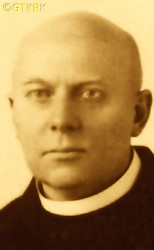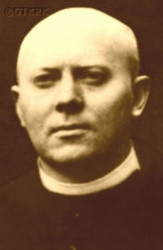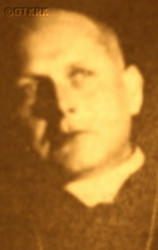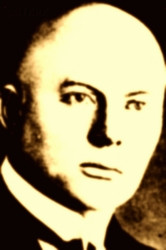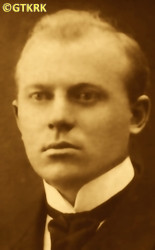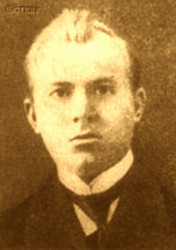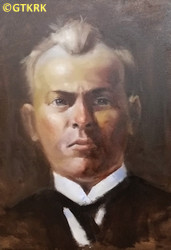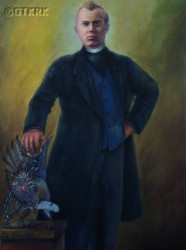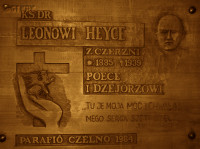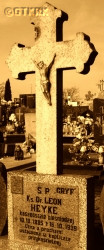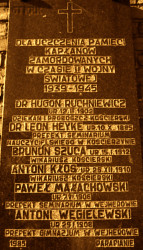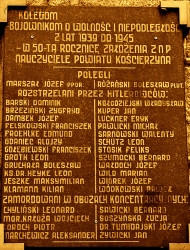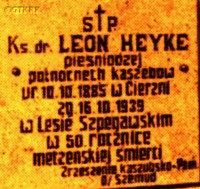Roman Catholic
St Sigismund parish
05-507 Słomczyn
85 Wiślana Str.
Konstancin deanery
Warsaw archdiocese, Poland
full list:
displayClick to display full list

searchClick to search full list by categories
wyświetlKliknij by wyświetlić pełną listę po polsku

szukajKliknij by przeszukać listę wg kategorii po polsku

Martyrology of the clergy — Poland
XX century (1914 – 1989)
personal data
surname
HEYKE
surname
versions/aliases
HEYKA
forename(s)
Leo (pl. Leon)
function
diocesan priest
creed
Latin (Roman Catholic) Church RCmore on
en.wikipedia.org
[access: 2014.09.21]
diocese / province
Culm (Chełmno) diocesemore on
pl.wikipedia.org
[access: 2012.11.23]
RC Military Ordinariate of Polandmore on
en.wikipedia.org
[access: 2014.12.20]
academic distinctions
Doctor of Sacred Theology
honorary titles
Ad Honores Spiritual Counselor
(c. 1938)
Gold „Cross of Merit”more on
en.wikipedia.org
[access: 2019.04.16]
(29.04.1930)
Silver „Academic Laurel” badge, Silver 2nd Class
(04.11.1937)
date and place
of death
16.10.1939

Szpęgawski foresttoday: Starogard Gdański gm., Starogard Gdański pov., Pomerania voiv., Poland
more on
en.wikipedia.org
[access: 2018.09.23]
details of death
While studying at Germ. Königliches Gymnasium (Eng. Royal Gymnasium) in Wejherowo — during Prussian times (partitions of Poland) — member (c. 1904‐1906) of the gymnasium chapter of a clandestine Polish self–education Pomeranian Philomaths organisation.
During World War I field chaplain and nurse in German Imperial Army — for two years, starting in 08.1914, served in Chełmno hospital, and then in Kriegsgefangenenlager (Eng. POW camp) KgL Hammerstein in Czarne, for captured Imperial Russian Army soldiers.
When on 09.11.1918, the German Emperor William II Hohenzollern abdicated; when on 11.11.1918, the Allies and the Germans, in a staff carriage in Compiègne, at the headquarters of French Marshal Ferdinand Foch, signed an armistice and ceasefire — which de facto meant the end of World War I; when on 11.11.1918 the Regency Council — operating in the territory of the Germ. Königreich Polen (Eng. Polish Kingdom) occupied by the Central Powers (Germany and Austria–Hungary) — transferred supreme command over the army to Brigadier Joseph Piłsudski and appointed him Commander‐in‐Chief of the Polish Army, which de facto meant the rebirth of the Polish state, covering however only the Germ. Königreich Polen, i.e. the Polish territory under Russian rule until 1915, and excluding the lands of the Prussian partition, e.g. the Germ. Provinz Westpreußen (Eng. West Prussian Province), which formally still remained part of the German state; ministered in Chmielno near Kartuzy, in the aforementioned Germ. Provinz Westpreußen. The struggle to join Pomerania to Poland was beginning. On 03‐05.12.1918, the Polish District Parliamen (Seym) met in Poznań and expressed its will to create a united Polish state with access to the sea. On 27.12.1918, the Greater Poland Uprising broke out. Then, on 01.1919, the organist in his church, Mr Peter Bukowski, organized a meeting, attended by 100 people. They demanded the resignation of the German village mayor, teaching in Polish at the local school, replacing German inscriptions with Polish ones, and organizing a unit of Polish public security guards.
In response, on 15.01.1919, a unit of the Germ. Grenzschutz Ost (Eng. Eastern Border Guard), a German paramilitary force, terrorist, volunteer formation, militarily opposing the separation of the eastern territories from Germany, appeared in Chmielno. The roads leading to Chmielno were blocked with machine guns. The organist was arrested, accused of proclaiming himself the „president of the Chmielno republic”, and taken away, threatened with death.
After 14 days in German prisons returned to Chmielno — the „Chmielno republic” took on a festive decoration, a triumphal gate was erected and the people led their hero with the „Who will entrust” religious song to his house.
It is not known what role played in these events, but they should be considered part of the Greater Poland Uprising that ended on 16.02.1919 with the armistice in Trier, enforced by the victorious Entente states. By virtue of the armistice, the Polish insurgent Greater Poland Army was recognized as an allied force and a border was established, the crossing of which „German troops were forbidden”. The formal fulfillment of the Polish victory was the peace treaty with Germany signed in Versailles on 28.06.1919 by the Entente powers. The Germ. Provinz Westpreußen was granted to Poland, but the determination of the precise border line was left to the international Delimitation Commission. On 10.01.1920, after the necessary ratifications, it became part of Poland.
In 1921, after the end of the wars for Poland's borders — including the Polish–Russian War of 1919‐1921 — transferred to the reserves of the Polish Army. In 1924, 1925, 1927, and 1929 appointed reserve chaplain (from 25.11.1926 each time for a statutory period of 2 years).
After German invasion of Poland on 01.09.1939 and start of the World War II (Russians invaded Poland 17 days later) left Kościerzyna and went south with refugee flow escaping from advancing Germans.
After start of the German occupation arrested on 13.10.1939 by the Germans in Wda (c. 50 km south of Kościerzyna).
Jailed in Starogard Gdański prison.
Tortured.
From there taken, along with 29 other Catholic priests, to the place of execution.The genocidal murders — in the middle of the Szpęgawski forest complex, c. 5 km north‐east of the center of Starogard Gdański in Pomerania — were carried out, as part of the Germ. «Intelligenzaktion» (Eng. Intelligence Action), i.e. the extermination of the Polish intelligentsia and leadership classes of Pomerania, by the genocidal unit of the Germ. Volksdeutscher Selbstschutz (Eng. Self–Defense of Ethnic Germans), whose members were Germ. Volksdeutsche (Eng. Ethnic Germans), i.e. representatives of the German minority in Poland from Starogard Gdański region. Supervisory functions were performed by a c. 12‐strong unit of Germ. SS‐Heimwehr Danzig (Eng. SS Home Guard Gdańsk) — formed on 20.06.1939 by the decision of the Senate of the Free City of Gdańsk on the basis of the 3rd „Götze” Battalion of the 4th „Ostmark” Regiment of the Germ. SS‐Totenkopfverbände (Eng. Death's Head Unit), responsible i.a. for the administration of concentration camps in Germany, constituting part of the paramilitary, genocidal Germ. Die Schutzstaffel der NSDAP (Eng. NSDAP Protection Unit), i.e. «SS», subordinate to the National Socialist German Workers' Party NSDAP — commanded by SS‐Obersturmführer, a certain William Fast.
The victims were transported from the Starogard Gdański prison in trucks or buses with black–painted windows, at dusk or at night. The transport traveled along side roads.
At the scene, the victims were forced to remove their shoes and then step — four by four — into a previously prepared pit. The first had to lie down with their hands folded across their foreheads or on the ground, while the others were forced to lie on the bloody bodies of their brothers.
They were shot in the neck, at the base of the head.
Those who survived were usually finished off with rifle butts or buried alive.
In the spring of 1940, trees were planted at the crime scene.
In 09.1939‐01.1940, the Germans murdered 5,000‐7,000 Poles in mass executions.
Among the victims were c. 49 Catholic priests — all, except one, from the Starogard Gdański district, including aforementioned 30 from the Chełmno Bishop's Curia and 5 from Pelplin. There were 1,692 patients of the psychiatric hospital in Kocborowo — murdered, starting from 22.09.1939, in 15 mass executions, as part of the «Aktion T4» program, i.e. an extermination action of Germ. „Vernichtung von lebensunwertem Leben” (Eng. „elimination of life not worth living”). The latter murders were allegedly carried out by the Germ. SS‐Wachsturmbann „Eimann” (Eng. Guard–assault unit „Eimann”), formed by a decree of the Senate of the Free City of Gdańsk of 03.07.1939, on the basis of the 36th Regiment of «SS», commanded by a certain SS‐Obersturmbannführer Kurt Eimann.
In some cases, „to save ammunition, some of the sick were beaten to death with rifle butts”.
In 26.10‐20.12.1944, facing the approaching German–Russian front and inevitable German defeat, as part of the Germ. „Sonderaktion 1005” (Eng. „Special Action 1005”), groups of prisoners prob. from the KL Stutthof concentration camp, referred to as Germ. „Leichenkommandos” (Eng. „Corpses' Units”) — under the supervision of Germans, members of the genocidal Germ. Sicherheitsdienst des Reichsführers SS (Eng. Security Service of the Reichsführer SS), i.e. «SD» — dug up the bodies of the murdered and burned them.
After the end of World War II, 39 death pits were discovered in the Szpęgawski forests.
cause of death
mass murder
perpetrators
Germans
sites and events
Szpęgawski forestClick to display the description, Starogard GdańskiClick to display the description, «Intelligenzaktion»Click to display the description, Reichsgau Danzig‐WestpreußenClick to display the description, Ribbentrop‐MolotovClick to display the description, Pius XI's encyclicalsClick to display the description, Pomeranian PhilomathsClick to display the description
date and place
of birth
10.10.1885

Cierżniatoday: part of Bieszkowice village, Wejherowo gm., Wejherowo pov., Pomerania voiv., Poland
more on
en.wikipedia.org
[access: 2022.01.28]
parents
HEYKE Ferdinand
🞲 06.02.1858, Cierżniatoday: part of Bieszkowice village, Wejherowo gm., Wejherowo pov., Pomerania voiv., Poland
more on
en.wikipedia.org
[access: 2022.01.28] — 🕆 18.11.1916, Kielnotoday: Szemud gm., Wejherowo pov., Pomerania voiv., Poland
more on
en.wikipedia.org
[access: 2022.01.28]

PLOTZKE Anne
🞲 09.04.1864, Kielnotoday: Szemud gm., Wejherowo pov., Pomerania voiv., Poland
more on
en.wikipedia.org
[access: 2022.01.28] — 🕆 01.03.1936, Kielnotoday: Szemud gm., Wejherowo pov., Pomerania voiv., Poland
more on
en.wikipedia.org
[access: 2022.01.28]
presbyter (holy orders)
ordination
13.03.1910

Pelplintoday: Pelplin gm., Tczew pov., Pomerania voiv., Poland
more on
en.wikipedia.org
[access: 2021.05.06]
positions held
1935 – 1939
prefect — Kościerzynatoday: Kościerzyna urban gm., Kościerzyna pov., Pomerania voiv., Poland
more on
en.wikipedia.org
[access: 2021.08.20] ⋄ Joseph Wybicki's State Gymnasium and High School ⋄ Holy Trinity RC parish ⋄ Kościerzynatoday: Kościerzyna urban gm., Kościerzyna pov., Pomerania voiv., Poland
more on
en.wikipedia.org
[access: 2021.08.20] RC deanery
04.1920 – 1935
prefect — Kościerzynatoday: Kościerzyna urban gm., Kościerzyna pov., Pomerania voiv., Poland
more on
en.wikipedia.org
[access: 2021.08.20] ⋄ State Teachers' Seminary for Men ⋄ Holy Trinity RC parish ⋄ Mirachowo / Kościerzynadeanery names/seats
today: Pomerania voiv., Poland RC deanery — chaplain and teacher of French
02.1920 – 04.1920
vicar — Kartuzytoday: Kartuzy gm., Kartuzy pov., Pomerania voiv., Poland
more on
en.wikipedia.org
[access: 2021.09.02] ⋄ Assumption of the Blessed Virgin Mary RC parish ⋄ Kartuzytoday: Kartuzy gm., Kartuzy pov., Pomerania voiv., Poland
more on
en.wikipedia.org
[access: 2021.09.02] RC deanery
20.03.1919 – 02.1920
vicar — Wygoda Łączyńskatoday: Stężyca gm., Kartuzy pov., Pomerania voiv., Poland
more on
en.wikipedia.org
[access: 2021.09.02] ⋄ Assumption of the Blessed Virgin Mary and St Joseph RC parish
01.1919 – 03.1919
vicar — Stężycatoday: Stężyca gm., Kartuzy pov., Pomerania voiv., Poland
more on
en.wikipedia.org
[access: 2021.09.02] ⋄ St Catherine of Alexandria the Virgin and Martyr RC parish ⋄ Mirachowotoday: Kartuzy gm., Kartuzy pov., Pomerania voiv., Poland
more on
en.wikipedia.org
[access: 2020.11.27] RC deanery
12.1918 – 01.1919
vicar — Chmielnotoday: Chmielno gm., Kartuzy pov., Pomerania voiv., Poland
more on
en.wikipedia.org
[access: 2021.09.02] ⋄ St Peter and St Paul the Apostles RC parish ⋄ Mirachowotoday: Kartuzy gm., Kartuzy pov., Pomerania voiv., Poland
more on
en.wikipedia.org
[access: 2020.11.27] RC deanery
08.1914 – 1918
RC military chaplain — German Imperial Army — served in a hospital in Chełmno (2 years) and in KgL Hammerstein POW camp in Czarne (2 years), also as a medic; prob. in 1921, after the end of the Polish–Russian War of 1919‐1921, transferred to the reserves of the Polish Army, verified with seniority from 01.06.1919, in the rank of captain
1914
vicar — Kościerzynatoday: Kościerzyna urban gm., Kościerzyna pov., Pomerania voiv., Poland
more on
en.wikipedia.org
[access: 2021.08.20] ⋄ Holy Trinity RC parish ⋄ Mirachowotoday: Kartuzy gm., Kartuzy pov., Pomerania voiv., Poland
more on
en.wikipedia.org
[access: 2020.11.27] RC deanery
03.1913 – 1914
vicar — Lubawatoday: Lubawa urban gm., Iława pov., Warmia‐Masuria voiv., Poland
more on
en.wikipedia.org
[access: 2021.09.02] ⋄ St Anne RC parish ⋄ Lubawatoday: Lubawa urban gm., Iława pov., Warmia‐Masuria voiv., Poland
more on
en.wikipedia.org
[access: 2021.09.02] RC deanery
11.1912 – 03.1913
vicar — Chojnicetoday: Chojnice urban gm., Chojnice pov., Pomerania voiv., Poland
more on
en.wikipedia.org
[access: 2021.09.02] ⋄ Beheading of St John the Baptist RC parish ⋄ Człuchówtoday: Człuchów gm., Człuchów pov., Pomerania voiv., Poland
more on
en.wikipedia.org
[access: 2021.09.02] RC deanery
1911 – 1913
PhD student — Wrocławtoday: Wrocław city pov., Lower Silesia voiv., Poland
more on
en.wikipedia.org
[access: 2021.04.02] ⋄ theology, Department of Catholic Theology, University of Wrocław [i.e. University of Wrocław (since 1945) / Frederic Wilhelm University of Silesia (1911‐1945) / Royal University i.e. Breslau Academy (1816‐1911)] — PhD thesis Germ. „Die Moraltheologie der sieben apokalyptischen Sendschreiben” (Eng. „Moral Theology of the Seven Catholic epistles”), public defense on 22.12.1913
1911
PhD student — Freiburg im Breisgautoday: Freiburg im Breisgau urban dist., Freiburg reg., Baden‐Württemberg state, Germany
more on
en.wikipedia.org
[access: 2020.07.31] ⋄ theology, Albrecht and Louis University
11.1910 – 02.1911
vicar — GdańskŚródmieście district
today: Gdańsk city pov., Pomerania voiv., Poland
more on
en.wikipedia.org
[access: 2022.02.24] ⋄ St Joseph RC parish ⋄ Gdańsk Ideanery name
today: Gdańsk city pov., Pomerania voiv., Poland
more on
en.wikipedia.org
[access: 2021.07.04] RC deanery
03.1910 – 11.1910
vicar — Lignowy Szlacheckietoday: Pelplin gm., Tczew pov., Pomerania voiv., Poland
more on
en.wikipedia.org
[access: 2021.12.18] ⋄ St Martin the Bishop and Confessor and St Margaret the Martyr RC parish ⋄ Gniewtoday: Gniew gm., Tczew pov., Pomerania voiv., Poland
more on
en.wikipedia.org
[access: 2021.07.29] RC deanery
1906 – 1910
student — Pelplintoday: Pelplin gm., Tczew pov., Pomerania voiv., Poland
more on
en.wikipedia.org
[access: 2021.05.06] ⋄ philosophy and theology, Theological Seminary
1898 – 1906
pupil — Wejherowotoday: Wejherowo gm., Wejherowo pov., Pomerania voiv., Poland
more on
en.wikipedia.org
[access: 2021.09.02] ⋄ Germ. Königliche Gymnasium (Eng. Royal Gymnasium) — studies crowned in 1906 with the maturity diploma (i.e. matura)
pupil — Bieszkowicetoday: Wejherowo gm., Wejherowo pov., Pomerania voiv., Poland
more on
en.wikipedia.org
[access: 2025.11.10] ⋄ elementary school
Kashubian poet, writer and playwright; author, among others books of poems „Northern Songs” (1911), „Kashubian songs” (1927), a series of humorous books „Bardzëńsczé wergle” (from 1922), a poem „Dobrogòst and Miłosława” (c. 1925), a collection of legends „Kashubian Tales” (Kościerzyna, 1931), „Outline of the history and activity of the Men's State Teaching Seminary in Kościerzyna” (1935, together with Franciszek Żurek), theater plays „Agùst Szlôga” (1935), „Katilina” (1937)
others related
in death
BAUMGARTClick to display biography Felix, BAUMGARTClick to display biography Francis, BŁĘDZKIClick to display biography Francis Raphael, BOROWSKIClick to display biography Leo, CHYLIŃSKIClick to display biography Gratian, CHYLIŃSKIClick to display biography Henry January Louis, CZAPLIŃSKIClick to display biography Francis Vladislav, DAMAClick to display biography Felix, DĄBROWSKIClick to display biography Boleslav John, DOERINGClick to display biography John, DRAPIEWSKIClick to display biography Marian John, GORDONClick to display biography Boleslav, GÓRNYClick to display biography Alphonse Francis, HOFFMANNClick to display biography Stanislav, JASIŃSKIClick to display biography Victor Luke, KARPIŃSKIClick to display biography Vladislav, KOZIORZEMSKIClick to display biography Bruno, KRZYŻANOWSKIClick to display biography Reginald Francis, KUCHENBECKERClick to display biography Joseph, LEWANDOWSKIClick to display biography Ambrose, PIECHOWSKIClick to display biography Julian, RAPIORClick to display biography Louis Joseph, RUDNIKClick to display biography Marian Matthias, SCHLIEPClick to display biography Casimir, STAWICKIClick to display biography Ignatius, SZPITTERClick to display biography John Anthony, WAŁDOCHClick to display biography John, ZAKRYŚClick to display biography Peter, ZYGMANOWSKIClick to display biography Marian
sites and events
descriptions
Szpęgawski forest: In Szpęgawsk forest Germans, as part of their «Intelligenzaktion» — extermination of Polish intelligentsia in Pomerania — between 09.1939 and 01.1940 in mass executions murdered 5,000‐7,000 Poles. Among them were c. 49 Catholic priests — all bar one from Starogard Gdański county, 30 from Culm diocese Curia and 5 from Pelplin. 1,692 psychiatric hospital patients in Kocborowo — in 15 mass executions starting from 22.09.1939 — part of «Aktion T4», i.e. Germ. „Vernichtung von lebensunwertem Leben” (Eng. „elimination of live not worth living”) extermination program, were also murdered there. The victims were brought from Starogard Gdański jail in trucks or buses with windows blackened at sunset or during the night. Transports avoided main roads. At murder site prisoners were forced to kneel at banks of the ditches and murdered by a shot to the back of the head. Wounded were finished off with rifle butts or buried alive. The murders were carried out mainly by the genocidal Germ. Volksdeutscher Selbstschutz (Eng. Self‐Defense of Ethnic Germans) unit, whose members were Germ. Volksdeutsche (Eng. ethnic Germans), i.e. representatives of the German minority in Poland from Starogard Gdański and vicinity, supervised by a c. 12‐strong unit called SS‐Heimwehr Danzig (Eng. SS Home Guard Gdańsk), commanded by a certain SS‐Obersturmführer Wilhelm Fast. The extermination of patients from the psychiatric hospital in Kocborowo was carried out by the SS‐Wachsturmbann „Eimann” unit (Eng. Guard and Assault Unit „Eimann”) established by a decree of the Senate of the Free City of Gdańsk of 03.07.1939, based on the 36th Regiment of the genocidal German «SS» organization, commanded by SS‐Obersturmbannführer Kurt Eimann. After the end of World War II, 39 mass graves were discovered in the Szpęgawski forests. (more on: en.wikipedia.orgClick to attempt to display webpage
[access: 2018.09.23])
Starogard Gdański: The prison in Starogard Gdański was built by the occupying Prussian authorities in 1893‐1912. In the interwar period, 1918‐1939, the facility was a penal and investigative prison for prisoners sentenced to up to 1 year in prison and served as a preventive detention center. After the German attack on Poland on 01.09.1939 and the commencement of the German occupation from mid‐09.1939 to 12.1939, the prison became a local temporary detention center, in which a special, c. 15‐person strong commission of the Germ. Geheime Staatspolizei (Eng. Secret State Police), i.e. Gestapo, and the genocidal self‐defense units Germ. Volksdeutscher Selbstschutz, whose members were Germ. Volksdeutsche (Eng. Ethnic Germans), i.e. representatives of the German minority in Poland — informally calling itself the so‐called Germ. Volksgericht (Eng. People's Court), i.e. a kangaroo court — carried out, without legal basis, at times by a single individual, the selection of detainees (c. 40 a day), deciding about their life and death. Some were sent to the arrests of Gdańsk (and then to the KL Stutthof concentration camp), and some were sentenced to death. Murders were carried out mainly in the nearby Szpęgawski forest. From 12.1939 to the end of the German occupation on 20.02.1945 the prison functioned as a court arrest. (more on: www.sw.gov.plClick to attempt to display webpage
[access: 2013.08.17])
«Intelligenzaktion»: German: «Intelligenzaktion» (English: „Intelligence Action”) — a German program of extermination of the Polish elite, mainly the intelligentsia and leadership layers, carried out from the beginning of the occupation in w 09.1939 to 04.1940, mainly in territories directly annexed to Germany, but also in the so‐called Germ. Generalgouvernement (Eng. General Governorate), where it was called «AB‐aktion». In the first phase, immediately after the beginning of the German occupation, during military operations carried out by the Germ. Wehrmacht (Eng. Armed Forces) and the genocidal units of the Germ. Einsatzgruppen (Eng. Operational Groups) of the Germ. Sicherheitspolizei (Eng. Security Police), i.e. SiPo, and Germ. Sicherheitsdienst des Reichsführers SS (Eng. Security Service of the Reichsführer SS), i.e. SD, organized by the Germ. Reichssicherheitshauptamt (Eng. Reich Main Security Office), i.e. RSHA, which followed the troops, carried out under the Germ. Unternehmen „Tannenberg” (Eng. Operation „Tannenberg”) — based on the so‐called Germ. Sonderfahndungsliste (Eng. Special Wanted Lists), i.e. proscription lists of Poles considered particularly dangerous to the Third Reich, prepared by the Zentralstelle II/P (Polen) unit of the German RSHA. Later, implemented by the German civilian occupation authorities and the genocidal unit of the Germ. Volksdeutscher Selbstschutz (Eng. Ethnic Germans Self‐Defense), whose members were Germ. Volksdeutsche (Eng. Ethnic Germans), i.e. representatives of the German minority in Poland. According to various sources, these lists, at the beginning of 09.1939, could have contained the details of 61,000—88,000 „dangerous” Poles — although these figures cannot be confirmed. In total, during this genocide, c. 50,000 teachers, Catholic priests, representatives of the landed gentry, freelancers, social and political activists, and retired military personnel were systematically and methodically murdered. Another 50,000 were sent to concentration camps, where only a negligible percentage survived. (more on: en.wikipedia.orgClick to attempt to display webpage
[access: 2014.10.04])
Reichsgau Danzig‐Westpreußen: After the Polish defeat in the 09.1939 campaign, which was the result of the Ribbentrop‐Molotov Pact and constituted the first stage of World War II, and the beginning of German occupation in part of Poland (in the other, eastern part of Poland, the Russian occupation began), the Germans divided the occupied Polish territory into five main regions (and a few smaller). The largest one was transformed into Germ. Generalgouvernement (Eng. General Governorate), intended exclusively for Poles and Jews and constituting part of the so‐called Germ. Großdeutschland (Eng. Greater Germany). Two were added to existing German provinces. From two other separate new provinces were created. Vistula Pomerania region was one of them, incorporated into Germany on 08.10.1939, by decree of the German leader Adolf Hitler (formally came into force on 26.10.1939), and on 02.11.1939 transformed into the Germ. Reichsgau Danzig‐Westpreußen (Eng. Reich District of Gdańsk‐West Prussia) province, in which the law of the German state was to apply. The main axis of the policy of the new province, the territory of which the Germans recognized as the Germ. „Ursprünglich Deutsche” (Eng. „natively German”), despite the fact that 85% of its inhabitants were Poles, was Germ. „Entpolonisierung” (Eng. „Depolonisation”), i.e. forced Germanization. C. 60,000 Poles were murdered in 1939‐1940, as part of the Germ. „Intelligenzaktion”, i.e. extermination of Polish intelligentsia and ruling classes, in c. 432 places of mass executions — including c. 220 Polish Catholic priests. The same number were sent to German concentration camps, from where few returned (over 300 priests were arrested, of whom c. 130 died in concentration camps). C. 124,000‐170,000 were displaced, including c. 90,000 to the Germ. Generalgouvernement. Poles were forced en masse to sign the German nationality list, the Germ. Deutsche Volksliste DVL. Polish children could only learn in German. It was forbidden to use the Polish language during Catholic Holy Masses and during confession. Polish landed estates were confiscated..To further reduce the number of the Polish population, Poles were sent to forced labor deep inside Germany. The remaining Poles were treated as low‐skilled labor, isolated from the Germans and strictly controlled — legally, three or three of them could only meet together, even in their own apartments. Many were conscripted into the German Wehrmacht army. After the end of hostilities of World War II, the overseer of this province, the Germ. Reichsstatthalter (Eng. Reich Governor) and the Germ. Gauleiter (Eng. district head) of the German National Socialist Party, Albert Maria Forster, was executed. (more on: en.wikipedia.orgClick to attempt to display webpage
[access: 2024.06.24])
Ribbentrop‐Molotov: Genocidal Russian‐German alliance pact between Russian leader Joseph Stalin and German leader Adolf Hitler signed on 23.08.1939 in Moscow by respective foreign ministers, Mr. Vyacheslav Molotov for Russia and Joachim von Ribbentrop for Germany. The pact sanctioned and was the direct cause of joint Russian and German invasion of Poland and the outbreak of the World War II in 09.1939. In a political sense, the pact was an attempt to restore the status quo ante before 1914, with one exception, namely the „commercial” exchange of the so‐called „Kingdom of Poland”, which in 1914 was part of the Russian Empire, fore Eastern Galicia (today's western Ukraine), in 1914 belonging to the Austro‐Hungarian Empire. Galicia, including Lviv, was to be taken over by the Russians, the „Kingdom of Poland” — under the name of the General Governorate — Germany. The resultant „war was one of the greatest calamities and dramas of humanity in history, for two atheistic and anti‐Christian ideologies — national and international socialism — rejected God and His fifth Decalogue commandment: Thou shall not kill!” (Abp Stanislav Gądecki, 01.09.2019). The decisions taken — backed up by the betrayal of the formal allies of Poland, France and Germany, which on 12.09.1939, at a joint conference in Abbeville, decided not to provide aid to attacked Poland and not to take military action against Germany (a clear breach of treaty obligations with Poland) — were on 28.09.1939 slightly altered and made more precise when a treaty on „German‐Russian boundaries and friendship” was agreed by the same murderous signatories. One of its findings was establishment of spheres of influence in Central and Eastern Europe and in consequence IV partition of Poland. In one of its secret annexes agreed, that: „the Signatories will not tolerate on its respective territories any Polish propaganda that affects the territory of the other Side. On their respective territories they will suppress all such propaganda and inform each other of the measures taken to accomplish it”. The agreements resulted in a series of meeting between two genocidal organization representing both sides — German Gestapo and Russian NKVD when coordination of efforts to exterminate Polish intelligentsia and Polish leading classes (in Germany called «Intelligenzaktion», in Russia took the form of Katyń massacres) where discussed. Resulted in deaths of hundreds of thousands of Polish intelligentsia, including thousands of priests presented here, and tens of millions of ordinary people,. The results of this Russian‐German pact lasted till 1989 and are still in evidence even today. (more on: en.wikipedia.orgClick to attempt to display webpage
[access: 2015.09.30])
Pius XI's encyclicals: Facing the creation of two totalitarian systems in Europe, which seemed to compete with each other, though there were more similarities than contradictions between them, Pope Pius XI issued in 03.1937 (within 5 days) two encyclicals. In the „Mit brennender Sorge” (Eng. „With Burning Concern”) published on 14.03.1938, condemned the national socialism prevailing in Germany. The Pope wrote: „Whoever, following the old Germanic‐pre‐Christian beliefs, puts various impersonal fate in the place of a personal God, denies the wisdom of God and Providence […], whoever exalts earthly values: race or nation, or state, or state system, representatives of state power or other fundamental values of human society, […] and makes them the highest standard of all values, including religious ones, and idolizes them, this one […] is far from true faith in God and from a worldview corresponding to such faith”. On 19.03.1937, published „Divini Redemptoris” (Eng. „Divine Redeemer”), in which criticized Russian communism, dialectical materialism and the class struggle theory. The Pope wrote: „Communism deprives man of freedom, and therefore the spiritual basis of all life norms. It deprives the human person of all his dignity and any moral support with which he could resist the onslaught of blind passions […] This is the new gospel that Bolshevik and godless communism preaches as a message of salvation and redemption of humanity”… Pius XI demanded that the established human law be subjected to the natural law of God , recommended the implementation of the ideal of a Christian state and society, and called on Catholics to resist. Two years later, National Socialist Germany and Communist Russia came together and started World War II. (more on: www.vatican.vaClick to attempt to display webpage
[access: 2023.05.28], www.vatican.vaClick to attempt to display webpage
[access: 2023.05.28])
Pomeranian Philomaths: Secret societies of Polish youth, aiming at self‐education, patriotic in form and content, functioning 1830‐1920, mainly in secondary schools — gymnasia — in Pomerania around Vistula river (Gdańsk Pomerania and Chełmno county), in Prussian‐occupied Polish territories (one of the partitions of Poland). On 08.01.1901 Germans conducted a series of interrogations of students at Chełmno, Brodnica and Toruń gymnasiums. On 09‐12.09.1901 the first of court trials of Polish students from those gymnasiums and students of Theological Seminary in Pelplin was held in Toruń. 1 person was sentenced to 3 months in prison, 1 to 2 months, 3 to 6 weeks, 7 to 3 weeks, 2 to 2 weeks, 19 to a week, 2 to 1 day, 10 were reprimanded. 15 were cleared. More definitive penalties were relegations from the schools with so‐called wolf’s ticket, forbidding sentenced students to continue secondary and higher studies in Prussia (Germany). Among those penalized were a few future Catholic priests — those were able to continue their education for the Chełmno diocese bishop, Bp August Rosentreter, refused to relegate students from Theological Seminary. (more on: pl.wikipedia.orgClick to attempt to display webpage
[access: 2018.11.18])
sources
personal:
www.najigoche.kaszuby.plClick to attempt to display webpage
[access: 2012.11.23], www.kaszubi.plClick to attempt to display webpage
[access: 2012.12.28], bckgw.plClick to attempt to display webpage
[access: 2023.02.20], picasaweb.google.comClick to attempt to display webpage
[access: 2013.08.10]
bibliographical:
„Biographical dictionary of priests of the Chełmno diocese ordained in the years 1821‐1920”, Henry Mross, Pelplin, 1995
original images:
bckgw.plClick to attempt to display webpage
[access: 2023.12.09], www.dziennikbaltycki.plClick to attempt to display webpage
[access: 2018.09.02], www.telewizjattm.plClick to attempt to display webpage
[access: 2018.09.02], bibliotekacyfrowa.euClick to attempt to display webpage
[access: 2018.09.02], bckgw.plClick to attempt to display webpage
[access: 2023.12.09], czec.plClick to attempt to display webpage
[access: 2018.09.02], bckgw.plClick to attempt to display webpage
[access: 2023.12.09], bibliotekacyfrowa.euClick to attempt to display webpage
[access: 2018.09.02], www.kaszubi.plClick to attempt to display webpage
[access: 2014.01.16], en.wikipedia.orgClick to attempt to display webpage
[access: 2014.01.16], www.kaszubi.plClick to attempt to display webpage
[access: 2014.01.16], www.geni.comClick to attempt to display webpage
[access: 2018.09.02], www.panoramio.comClick to attempt to display webpage
[access: 2014.10.31], koscierzynapejzaze.wixsite.comClick to attempt to display webpage
[access: 2018.09.02], bibliotekacyfrowa.euClick to attempt to display webpage
[access: 2018.09.02]
LETTER to CUSTODIAN/ADMINISTRATOR
If you have an Email client on your communicator/computer — such as Mozilla Thunderbird, Windows Mail or Microsoft Outlook, described at WikipediaPatrz:
en.wikipedia.org, among others — try the link below, please:
LETTER to CUSTODIAN/ADMINISTRATORClick and try to call your own Email client
If however you do not run such a client or the above link is not active please send an email to the Custodian/Administrator using your account — in your customary email/correspondence engine — at the following address:

giving the following as the subject:
MARTYROLOGY: HEYKE Leo
To return to the biography press below:
 Click to return to biography
Click to return to biography








